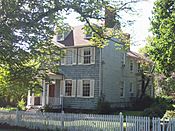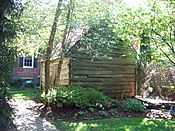Elkridge Furnace Complex facts for kids
Quick facts for kids |
|
|
Elkridge Furnace Complex
|
|

Elkridge Furnace House, September 2009
|
|
| Location | 5730 and 5741-5745 Furnace Ave., 5735 Race Rd., Elkridge, Maryland |
|---|---|
| Area | 6 acres (2.4 ha) |
| Architectural style | Greek Revival, Federal |
| NRHP reference No. | 90000635 |
| Added to NRHP | June 28, 1990 |
The Elkridge Furnace Complex is a historic site in Elkridge, Howard County, Maryland. It covers about 16 acres. This complex was once a busy place where people made iron. It operated from the 1700s until the 1860s.
Contents
What is the Elkridge Furnace Complex?
The Elkridge Furnace Complex has six buildings that are still standing today. These buildings were part of an old iron furnace. An iron furnace is like a huge oven used to melt iron ore and turn it into useful metal.
- One large house, built around 1835, was where the furnace owner lived. It has a mix of Federal and Greek Revival styles.
- There's also a wooden house from about the same time. This was probably for a manager or a clerk.
- You can see a two-and-a-half-story building. This was a company store and possibly a hotel or dormitory for the workers.
- Two smaller buildings from the 1800s might have been living quarters for enslaved people.
- There's also a brick duplex from the mid-1800s where workers lived.
Today, the 1835 Elkridge Furnace Inn is a restaurant and a place for special events. This important historical site was added to the National Register of Historic Places in 1990.
History of the Ironworks
The area around the Patapsco River had a lot of iron ore. This ore was dug up from the riverbanks. Sometimes, the digging caused sand and earth to fall into the river. This made it harder for boats to travel. In 1753, a law was made to stop the river from filling up near Elkridge Landing and Baltimore.
Early Iron Production
Caleb Dorsey was an ironmaster, a person who owned or managed an ironworks. He knew about the iron ore in the Patapsco River valley. In 1751, he started the Elkridge Furnace. Later, after 1761, he also built Dorsey's Forge upriver.
England needed iron from its colonies. To encourage this, England removed taxes on iron pigs in 1750 and iron bars in 1757. This made it good business to produce iron in Maryland.
The furnace used water power to work. Water was sent through a special channel to a water wheel. The turning water wheel powered a gear system. This system then moved bellows, which are like giant air pumps. The bellows blew air onto the charcoal fire, making it very hot for melting iron.
Dorsey's Forge made things like nails and horseshoes. This was actually against English law, which wanted the colonies to only send raw materials, not finished products. During the American Revolutionary War, Caleb Dorsey helped by making cannons and bayonets for the American forces.
In 1772, Caleb Dorsey's sons, Samuel and Edward Dorsey, took over the family business. When Samuel died in 1787, at least nine enslaved people worked at his iron operation.
New Owners and Growth
In 1822, the Ellicott family from Pennsylvania bought Dorsey's Forge and the Elkridge Furnace land. They created the Avalon Iron Works. Andrew Ellicott built a new furnace in 1826. This new furnace made nails and rolled and split iron.
By the 1800s, pig iron was used to make nails using water power at the forge. The complex grew, and by the 1850s, more than 100 people worked there. However, iron prices dropped sharply. The Ellicott's furnace operations faced financial trouble. In April 1850, the Union Bank of Maryland bought 700 acres, including the forge, for $25,000.
Floods and End of Operations
In 1854, the Great Falls Iron Company bought the Furnace. But nature had other plans. In 1868, a big flood destroyed the forge, factory, mill, and deep water channels. Enough of the complex was rebuilt to keep making iron until 1873. Then, another flood hit. This time, floodwaters mixed with the molten iron, causing a huge explosion that destroyed the facility for good.
Only two structures remained after the floods. One of them, the Furnace Inn, is now part of a small section of the Patapsco Valley State Park.
Gallery





